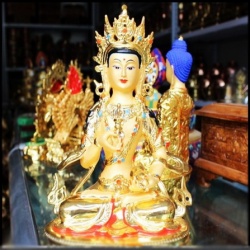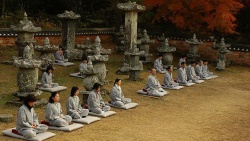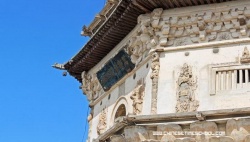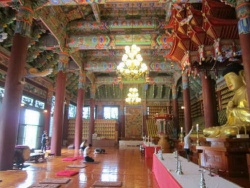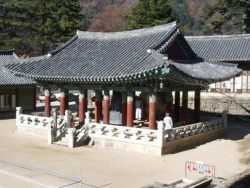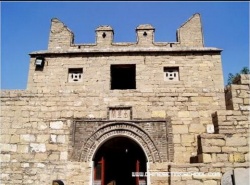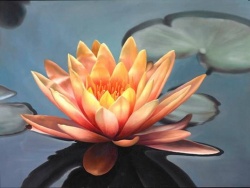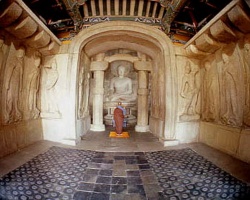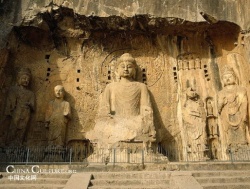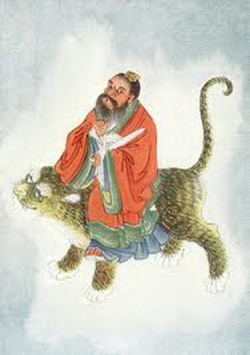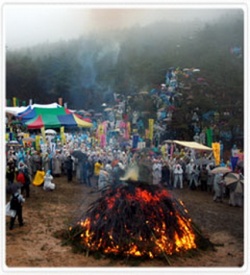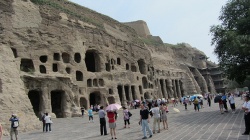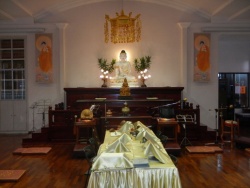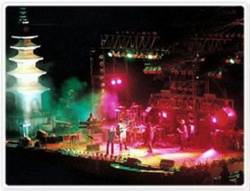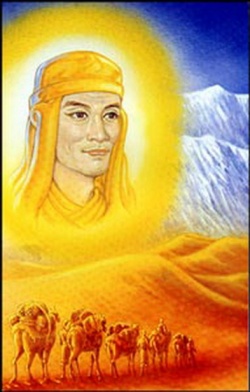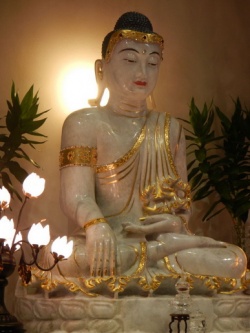Asvaghosha
Buddhist Poet and Philosopher
Aśvaghoṣa (80-150 CE) (अश्वघोष) was an Indian philosopher-poet, born in Saketa in northern India to a Brahmin family. He is believed to have been the first Sanskrit dramatist, and is considered the greatest Indian poet prior to Kālidāsa. He was the most famous in a group of Buddhist court writers, whose epics rivaled the contemporary Ramayana. Whereas much of Buddhist literature prior to the time of Aśvaghoṣa had been composed in Buddhist Hybrid Sanskrit, Aśvaghoṣa wrote in Classical Sanskrit]]. According to the traditional biography of Aśvaghoṣa, which was translated into Chinese by Kumārajīva, and preserved in that language, he was originally a wandering ascetic who was able to defeat all-comers in debate. He set a challenge to the Buddhist monks that if none could meet with him in debate then they should stop beating the wood-block which signaled to the people to bring offerings to them. There was no one there to meet the challenge so they stopped beating the wood-block.
However, in the north there was an elder bhikṣu named Pārśva at the time, who saw that if he could convert this ascetic, it would be a great asset to the propagation of the Dharma, so he traveled from northern India, and had the wood-block sounded. The ascetic came to ask why it had been sounded and though thinking the old monk would be unable to debate with him, he accepted his challenge, and after seven days the debate was held in front of the King, his Ministers, and many ascetics and brahmans. The loser agreed to become the disciple of the other.
They agreed that the elder Pārśva should speak first, and he said: "The world should be made peaceable, with a long-lived king, plentiful harvests, and joy throughout the land, with none of the myriad calamities", to which the ascetic had no response and so was bound to become Pārśva's disciple, and he was given full ordination as a bhikṣu.
Although he had to consent to this, he still wasn't convinced of the elder's virtues until he showed him he had mastered the Bases of Spiritual Power , at which point he gained faith. Pārśva then taught him the 5 Faculties, the 5 Powers, the 7 Factors and the 8-fold Noble Path and he eventually mastered the teaching.
Later the central kingdom was besieged by the Kuṣāna King's army, who demanded 300,00 gold pieces in tribute. The King could not pay so much as he had only 100,000. The Kuṣāna King therefore asked for the Buddha's begging bowl, the converted monk and the 100,000 gold pieces for his tribute.
Although the King of the central kingdom was unhappy, the monk persuaded him it would be for the good of the propagation of the Dharma which would spread across the four continents if he went with the Kuṣāna King. He was therefore taken away.The Kuṣāna's King's Ministers however, were unhappy, not thinking that the bhikṣu was priced correctly at 100,000 gold pieces. The King, who knew his worth, ordered that seven horses be starved for six days, then he made an assembly and had the bhikṣu preach the Dharma.
Even the horses, whose favorite food was placed in front of them, were entranced by the Teaching of the monk, and listened intently. Everybody was thereby convinced of his worth, and he then gained the name Aśvaghoṣa, Horse-Cry.
He traveled throughout northern India proclaiming the Dharma and guiding all through his wisdom and understanding, and he was held in great regard by the four-fold assembly, who knew him as The Sun of Merit and Virtue.
He was previously believed to have been the author of the influential Buddhist text Awakening of Mahayana Faith, but modern scholars agree that the text was composed in China. And it is now believed he was not a Mahayanist, and seems to have been ordained into a subsect of the Mahasanghikas.
He wrote an epic life of the Buddha called Buddhacarita (Acts of the Buddha) in Sanskrit. I-tsing (Yijing) mentioned that in his time Buddhacarita was "...extensively read in all the five parts of India and in the countries of the South Sea (Sumātra, Jāva and the neighbouring islands). He clothed manifold notions and ideas in a few words which so delighted the heart of his reader that he never wearied of perusing the poem. Moreover it was regarded as a virtue to read it in as much as it contained the noble doctrine in a neat compact form."
It described in 28 chapters the whole Life of the Buddha from his birth until his entry into Parinirvāna, but during the Muslim invasions of the 10th - 12th centuries half of the original text was lost in Sanskrit, and today the second half only exists in Chinese and Tibetan translations.
He also wrote Saundaranandakavya, a kāvya poem with the theme of conversion of Nanda, Buddha’s half-brother, so that he might reach salvation. The first half of the work describes Nanda’s life, and the second half of the work describes Buddhist doctrines and ascetic practices.
He is also thought to be the author of the Mahālaṅkāra (Great Ornament).
According to Geshe Ngawang Dakpa of Sera Je Monastery in a 2008 Dharma Talk, "Aryadeva was an Ayurvedic medicine doctor monk just like Aśvaghoṣa and Nāgārjuna."
Quite positively Aśvaghoṣa came of a Brahman family and had a sound Brahmanic education before he went over to Buddhism. As a Buddhist he joined, we may surmise, at first the Sārvāṣṭivāda school but laid great stress on Buddha Bhakti and thus prepared for the Mahāyāna. As his birthplace or home is mostly mentioned Sāketa or Ayodhya, modern Oudh. But Benares and Patna are also mentioned in this connection. His mother's name was Suvarṇakṣī. The Tibetan life of Aśvaghoṣa says of him: “There was no question that he could not solve, there was no objection which he would not remove; he threw down his opponents as fast as a strong wind breaks down decayed trees.”
According to the same account he was a distinguished musician who himself composed music and with his troupe of minstrels, male and female, roamed through market towns. There he played and sang with his choir melancholy ditties on the nullity of existence and the crowd stood charmed with his entrancing melody. In this way he won many over to his religion. According to Vaśubandhu he assisted Kātyāyaniputra in the preparation of his commentary on the Abhidharma.
The Chinese pilgrim I-tsing, who journeyed through India in 671-695 speaks of the learned monks who successfully combated the heretics, furthered the religion of the Buddha and were consequently esteemed higher than gods and men by the people. And he adds that in each generation there are only a couple of such men - men like “Nagārjuna, Āryā-Deva and Aśvaghoṣa of antiquity.” [30]
Hiuen-tsiang calls Aśvaghoṣa, Deva, Nāgārjuna and Kumāralabdha “the four suns which illuminate the world” (Sacred Books of the East Vol. 49, p. 9). The same I-tsing relates how in his time in India was read in front of Buddhist shrines inter alia a manual of sacred texts prepared by Aśvaghoṣa. He also knows him as the author of hymns, of Sūtrālaṁkāra and of the Buddhacarita .
Aśvaghoṣa's Great Work: the Buddha's Biography
Of the Buddhacarita I-tsing says that it was a voluminous poem which recounted the life and the work of the Buddha “from the time when he was still living in the royal palace till his last hour in the park of the sal trees.” He adds: “It is extensively read in all the five parts of India and in the countries of the South Sea (Sumātra, Jāva and the neighbouring islands). He clothed manifold notions and ideas in a few words which so delighted the heart of his reader that he never wearied of perusing the poem. Moreover it was regarded as a virtue to read it in as much as it contained the noble doctrine in a neat compact form” (I-tsing p. 165 f.). From what I-tsing says it follows that he knew the Buddhacarita in the form of its Chinese translation in which the epic consists of 28 cantos and the narrative is brought down to the Nirvāṇa of the Buddha.
It is the Fo-sho-hing-t-tsan translated from Sanskrit into Chinese between 414 and 421 by Dharmarakṣa and by Beal from Chinese into English in Sacred Books of the East XIX, Rhys Davids (Journal of the Royal Asiatic Society 1901, p.405 f.) has rightly emphasized that this Chinese work is no translation in our sense. Much more accurate is the rendering of the 7th or 8th century into Tibetan (Leumann, WZKM 7,1893, p, 193 ff.).
Now since the Tibetan translation also contains 28 cantos we must indeed suppose that in the Sanskrit text which comprises only 17 cantos and terminates with the [31] conversions in Benares we have only a torso; and in fact it is but a torso. For out of these 17 cantos only the first 13 are old and genuine. The concluding portion was supplied by one Amtānanda, who lived as a copyist in the beginning of the 19th century, because he himself admits he could find no complete manuscript. Even the manuscript of the Buddhacarita discovered by Haraprasada Shastri reaches down only to the middle of the 14th canto (Journal of the Asiatic Society of Bengal Vol. 5 p. 47 ff.).
And what the Chinese pilgrim says in eulogy of the Buddhacarita we can completely substantiate on the basis of the torso we possess. Here we have in reality for the first time a proper Buddha epic created by a true poet - a poet who, permeated with love and reverence for the exalted person of the Buddha and profound reverence for the verity of the doctrine of the Buddha, represents the life and the teaching of the master in noble language of art which is not artificial. The Buddhacarita is technically called a Mahākāvya or great poem - a courtly epic in art and it is composed in the style appropriate to Kāvya, the beginnings of which we find in the Rāmāyana. Vālmīki and his immediate followers were the predecessors of Aśvaghoṣa just as the latter himself was a forerunner of Kāḷidāsa. All the three great poets, however, agree in this that in the employment of Alaṁkāras or poetic embellishment they are throughout moderate. And moderate as to language and style is Aśvaghoṣa also in the presentment of the miraculous in the Buddha legend. He eschews the extravagance such as we find for example in the Lalitavistara.
In contrast with the chaotic disorder of the text of the Mahāvastu and the Lalitavistara we find in the Buddhacarita considered and artistic arrangement of the material. And although the poet is at home with the older sacred texts he stands independent of them. Not that he has in any way [32] altered the tradition; he understands how to invest with a new poetic garb the legend known of old and to lend originality of expression to the doctrine of the primitive Buddhistic sūtras. Always is Aśvaghoṣa more of a poet than a monk - at least in his Buddhacarita. As Windisch observes, Aśvaghoṣa seems to have diligently avoided the ring of the phraseology of the older texts (Māra and Buddha, p. 205).
Buddhacarita and Kāḷidāsa
Quite differently poetical for instance from that of the Lalitavistara is the picture of the young prince going out for a walk in cantos 3 and 4.
Here in a charming way is depicted how when the news arrives that the prince had gone out the ladies of the city in their curiosity hasten from their chambers to the roofs of the houses and to the windows, hindered by their girdles which fall off, and rush forward with the greatest haste pressing on and pushing each other, frightening by the clank of their waistbands and the ring of their ornaments the birds on the roofs. The faces of the beauties, charming as lotus, gleaming out of the windows appear, as if the walls of the houses were really decorated with lotus flowers. As Cowell has already noticed in the preface to his edition the Buddhacarita, Kāḷidāsa has imitated this scene from Aśvaghoṣa (Buddhacarita, iii 13/24) in his Raghuvaṁśa (vii, 5/12). The meeting with the old man whom the gods cause to appear before the prince is charmingly described. In his astonishment the prince asks:
“Who is the man coming this side, oh charioteer?
With white hair, eyes sunk deep in their socket,
Bending over his staff, his limbs quavering?
Is that Nature's course or a sport of Chance?” [33]
To this the charioteer replies:
“Old age it is that has broken him - age,
The thief of beauty and the destroyer or strength,
The source of sorrow and the end of joy,
The foe of intelligence and the disappearance of memory.
He too sucked at his mother's breast,
As a child learnt to walk in course of time.
Slowly he grew big and strong - a youth,
By degrees has old age crept on him.”
After the prince had on his three walks out of his palace learnt of old age, disease and death, no more could he find any joy in life. It is in vain that the family priest by order of the king calls upon the women and maidens of the palace to bend their energies on their seductive art to soothe the prince and turn him from his distressing thoughts. The prince remains untouched by the soft distractions. He only thinks of the unthinking ways of these women and cries out (iv 60 f.):
“How senseless the man appears to me whose neighbour ill and old and dead he
Sees and yet holds fast to the good things of this life and is not thrilled with anxiety.
It is as if a tree divested of all flower and fruit must fall or be pulled down -
Unaffected remaining the neighbouring trees.
”
Statecraft, Erotic Art and Warfare
The presentment of the love scenes belongs to the indispensable element in the poetic are as an appanage to the court. And the poet satisfies this demand in depicting the sports of the lovely maidens who endeavour to draw the prince towards themselves (iv, 24/53) just as well as in the vivid portrayal of the [34] night scene in the ladies' chamber which causes the prince to fly from the palace. These themes give Aśvaghoṣa the opportunity for the display of his erotic art. It may be noted that the description (v, 48/62) in its primitive shape is recounted by the young Yasa in the Pāḷi Vinayapiṭaka. We have already had occasion to remark that a similar scene in the Rāmāyana (v, 9/11) has been copied from this Buddhist poet Aśvaghoṣa. The court poet, however, must also be familiar with the doctrine of the nītiśāstras or statecraft. And the world-wide principles are unfolded to the prince by the priest attached to the royal household in order to divert his mind from his meditations (iv, 62/82). Finally, belonging to the same species of court poetry is the delineation of the battle scene. Here our poet rises to the occasion in that in the thirteenth canto he conjures up a vivid scene of the struggle of the Buddha with Māra and his hordes.
Love and Religion
Aśvaghoṣa was the author of another poem to be classed in the category of court poetry viz.,Saundaranandakāvya. The lucky discoverer and editor of this poem is Pandit Haraprasada Shastri (A. Bastion,Journale Asiatique 1902, vol. xix, p. 79 ff and F. W. Thomas Journal of the Royal Asiatic Society 1911 p. 1125). It also turns round the history of the Buddha's life, but limns especially those scenes and episodes which have been either lightly touched upon or not treated at all in the Buddhacarita. Thus in the first canto is exhaustively described the history of the finding of the city of Kapilavastu. The actual content of this poem, however, is constituted by the history of the loves of Sundarī and Nanda, the half-brother of the Buddha who is initiated into the Order against his will by the latter: [35]
Just as Sundarī, the lovely bride of Nanda, weeps and wails over her lost husband so does Nanda suffer for his beloved. Vain are the attempts of the brother monks to tranquilize him. Even the word of the Buddha is impotent to reconcile him. Then the Master takes him by the hand and rises with him to heaven. On their way they see in the Himālayas a hideous one-eyed female monkey and the Buddha asks Nanda if Sundarī was more charming than she and Nanda naturally says ‘Yes’ with energy. Soon after, however, they see in the heaven the apsaras or celestial nymphs and Nanda finds that the difference between them and his wife is as great as that between the latter and the one-eyed ape. From this moment onwards he is possessed with a passionate longing for the fairies and returning on earth gives himself up to serious ascetic practices in order to be able to attain to the paradise.
Thereupon Ānanda, the favourite disciple of the Buddha, teaches him that even the joys of paradise are vain and nugatory. Nanda is finally convinced and goes to the Buddha to say that he had no longer a desire for the beauties of heaven. The Buddha is greatly pleased and preaches to him in several cantos the cardinals of his doctrine. Nanda now retires into the forest, practises the four great meditations and becomes an arhat. Gratefully he betakes himself to the Buddha and does him reverence but the Master calls upon him now that he has attained his object, out of compassion for others to preach the doctrine of salvation and conduct others to emancipation.
The reference to the forcible conversion of Nanda occurs also in our older sources: Mahāvagga, i. 54; Nidānakathā p. 91; Rhys Davids Buddhist Birth Series, p. 128. As is pointed out by Haraprasada Shastri (p. xiii) a strongly divergent version of this legend is to be found in the Pāḷi commentary on the Dhammapada. See also Spence Hardy, Manual of Buddhism; Kern, History of Buddhism. i, 155; Foucher, Greco-Buddhist Art (i, 464). [36]
Synthesis of Schools
Whilst in the Buddhacarita there is no express doctrine emanating from the Mahāyāna school the concluding portion of the Saundaranandakāvya already begins to betray a leaning towards the Mahāyāna. lt is not sufficient for it that Nanda himself should become a saint who attains to Nirvāṇa. He must also be an apostle of the faith, although it must not be forgotten that even in the Hīnayāna the obligation of the propagation of the faith and proselytism is highly praised, as in a Sūtra in the Aṅguttaranikāya [which one is he thinking of?]. Besides in the third great work of Aśvaghoṣa entitled the Sūtrālaṁkāra, which we up to now knew only from a French translation of the Chinese version belonging to about 405 B.C., many of the semi-legendary stories are based on a Hīnayānic foundation.
From this Sūtrālaṁkāra translated into French from the Chinese version of Kumārajīva, Huber was able to trace three stories to the Divyāvadāna (Bulletin de l'Ecole Francaise d'Extreme Orient, 1904, pp. 709-726) but fragments of the Sanskrit original have more recently been discovered at Turfan and studied by Luders in an old palm leaf manuscript (see Fragments of Buddhist Drama, Berlin, 1911, and Vallee Poussin Le Museon, 1909, p. 86.)
Sūtrālaṁkāra
Sūtrālaṁkāra or “Sūtra-Ornament” is a collection of pious legends after the model of the Jātakas and Avadānas which are narrated in prose and verse in the style of Indian poetic art. Many of these legends are known to us of old e.g., that of Dīrghāyus or prince Long-Life and of king Śibi. Others already show more of the spirit of the Mahāyāna or at least a reverence for the Buddha which is more Mahāyānistic in its tendency. An illustration is furnished by story No. 57, which happens also to be one of the most charming in the collection. [37]
A man comes to the monastery and desires to be initiated into the Order. The disciple Śāriputra examines him and finds that the candidate in none of his previous existences for aeons had done the smallest good deed and pronounces him unworthy of admittance. The man leaves the monastery in tears. Then the Buddha himself meets him and the Buddha's heart being full of compassion he strives to convert all mankind with the love that a mother bears to her son. He lays his hand on the head of the rejected one and asks “Why dost thou cry"? And the latter relates to him how Śāriputra had dismissed him. Thereupon the Buddha consoles him “in a voice that resounded like distant thunder” and adds that Śāriputra was not omniscient. The Buddha himself then brings the man back to the monastery and relates before all the monks the karma, which was a good act whereby the man had acquired right to emancipation. Once upon a time in his previous birth this person was a poor man who was wandering in a hill forest to collect wood, when a tiger rushed at him. Filled with terror he cried out “adoration to the Buddha”. On account of these words the man must partake of deliverance from sorrow. The Buddha himself initiated him and presently he became an Arhat.
An example of a real Mahāyānistic Buddha-bhakti is also furnished by No. 68, where Gautamī, the foster mother of the Buddha, attains to Nirvāṇa through the grace of the Buddha.
That the Sūtrālaṁkāra is of later origin than the Buddhacarita is proved by the fact that the latter is quoted in the former (Huber, page 192, 222). Since in two of the stories of the Sūtrālaṁkāra a part is played by king Kaniṣka, Aśvaghoṣa must have lived at the time of the composition of the book as an old man at the court of the king. But it is much to be deplored that up to now we [38] have only Chinese translations of the Sūtrālaṁkāra. The Sanskrit text so far has never been discovered. Not only is it in itself a literary work of importance the merits of which impress themselves upon us through two translations, first Chinese and then French, as has been appropriately observed by Levi, but it is not of trifling significance for the history of Indian literature and culture inasmuch as it mentions the epics of the Mahābhārata and Rāmāyana, it combats the philosophical doctrine of the Saṁkhyā and Vaiśeṣika schools just as forcibly as it opposes the religious views of the Brahmans and the Jains and refers in a variety of ways to the scripts, to the arts and to painting. Still more is uncertainty a matter for regret with reference to a few other books which are attributed to Aśvaghoṣa. It is a question whether they really belong to him. This applies especially to the Vajrasūci or Diamond Needle which is in any case an interesting little book in which there is a vehement polemic against the caste system of the Brahmans.
Vajrasūci : Polemic against Caste
The Vajrasūci or refutation of the Arguments upon which the Brahmanical institution of the caste is founded by the learned Buddhist Aśvaghoṣa (edited by Lancelot Wilkinson) also the Tunku by Soobajee Bapoo, being a reply to the Wujra Soochi, l839. A Weber, Uber die Vajrasūci (Abdhandlungen der Preuss Akademie der Wissenschaften phil. hist. Kl. 1859, S. 295 ff. und Indische Streifesn 1, 116 ff.) B. H. Hodgson Essays on the Languages, Literature and Religion of Nepal and Tibet, London 1874, p 126 ff. and S. Levi A. 1908, s· 10 t, XII p. 70 f.
Here the author very effectively takes up the Brahmanic standpoint and demonstrates on the authority of Brahmanic texts and citations from the Veda, the Mahābhārata and Manu the invalidity of the claims of caste as recognised by Brahmans. When in 1829 Hodgson published a translation of the books and Wilkinson in 1839 published an edition they astonished scholars by the democratic spirit of Europe displayed in the book. In this tract the doctrine of equality [39] of mankind has been advocated; for all human beings are “in respect of joy and sorrow, love, insight, manners and ways, death, fear and life, all equal.” Did we but know more about the author and the time when the book was composed it would be of much greater importance for the literary history of India on account of the quotations from Brahmanic texts. It speaks for the authorship of Aśvaghoṣa that in Sūtrālaṁkāra No. 77 the Brahmanic institutions are arraigned with the help of quotations from Manu's law book just as in the Vajrasūci. On the other hand the Vajrasūci is enumerated neither in the Tibetan Tanjur nor among the works of Aśvaghoṣa by I-tsing; and further in the Chinese Tripiṭaka Catalogue the Vajrasūci, which is said to contain “a refutation of the four vedas,” is described as translated into Chinese between 973 and 981 and is ascribed to a Dharmakīrti (Bunyo Nanjio, Catalogue of the Chinese translation of the Buddhist Tripiṭaka, No. 1303). The Chinese term “fa-shang” is the translation of the Sanskrit proper name Dharmakīrti.
Other Works of Aśvaghoṣa
It is altogether undecided whether other books the authorship of which is assigned to Aśvaghoṣa by Chinese, Japanese and Tibetan writers were actually composed by him. The fame of Aśvaghoṣa as a teacher of the Mahāyāna is founded on his Mahāyāna Śraddhotpada or the Rise of the Mahāyāna Faith, a philosophical treatise studied in the monasteries of Japan as the basis of the Mahāyāna doctrine. “The poet of the Buddhacarita,” says Levi “shows him(self) here as a profound metaphysician, as an intrepid reviver of a doctrine which was destined to regenerate Buddhism.” However it is anything but certain or rather highly improbable that it is in reality the product of Aśvaghoṣa since it embodies teaching which is assignable to a later date. So long, however, as the Sanskrit [40] text of the book is denied us a final judgment regarding the age of the author is impossible.
The Śraddhotpada was translated first in 534 and then in 710 A.D. into Chinese. From the second Chinese translation T. Suzuki prepared an English version, “Discourse on the Awakening of Faith in the Mahāyāna.” Suzuki holds Aśvaghoṣa the poet to be the author and asserts on the basis of the book itself, the Mahāyāna Śraddhotpada, that he was the actual founder of the Mahāyāna sect. The doctrine which the book incorporates is, however, that of Vijñānavāda as taught by Asaṅga and the teaching of Tathāgatagarbha and the Tathatā which occurs in Laṅkāvatāra. Professor Takakusu, who holds the authorship of the poet Aśvaghoṣa as altogether out of question, says that the older catalogue of the Chinese texts does not contain the name of Aśvaghoṣa as the author. In the Tibetan Tanjur Aśvaghoṣa is also described as the composer of the Śatapañcāśatikastotra, the panegyric in 150 verses, which according to I-tsing, is the work of the poet Mātceta. In fact I-tsing cannot say too much regarding the renown of this Mātceta, who at all events belongs to the same school as Aśvaghoṣa and is accordingly confused with him.
Mātceta
To follow the Tibetan historian Taranātha, Mātceta is only another name of Aśvaghoṣa, (F.W., ThomasOrientalistenkongresse XIII, 1902, p. 40). One dare not decide whether our Mātceta is identical with the Mātceta, the Author of the Mahārājakanikalekha, (Thomas Ind. Ant., 1903, p. 345 ff. and S. C. Vidyabhushana Journal of the Asiatic Society of Bengal, 1910, p. 477 ff.) “It is entrancing,” says I-tsing, “in the congregation of the monks to hear recited the hymn in 150 verses or the hymn in 400 verses. These fascinating poems are like heavenly flowers in their [41] beauty and the exalted principles which they contain emulate in dignity the height of mountain summits. Therefore all the composers of hymns in India imitate his style regarding him as the father of literature. Even men like the Bodhisattva Asaṅga and Vaśubandhu greatly admire him. Throughout India every monk, as soon as he is able to recite the five or ten commandments, learns the psalms of Mātceta.”
The legend would have it that in a previous birth he was a nightingale which eulogised the Buddha in charming melody. I-tsing himself translated from Sanskrit into Chinese the hymn of 150 verses (Record, p. 156, 666). Now, however, most fortunately we have discovered in Central Asia fragments of the Sanskrit originals of the hymns of Mātceta and from the mutilated manuscripts discovered at Turfan, to which we already owe so much, Siegling has succeeded in reconstructing almost two-thirds of the text. The verses are in the artistic, but not the extravagant Kāvya, style. Besides Dr. Siegling who has been preparing an edition for the press similar fragments discovered in Central Asia have been published by Levi (Journale Asiatique 1910, page 455, and Vallee Poussin 1911, page 764) F. W. Thomas translated one of the Mātceta's poems the Varṇanārthavarṇanā, from the Tibetan rendering into English (Ind. Ant. vol. 34, p. 145).
Buddhist Poet Śūra
Better known is the poet Śūra or Āryaśūra, probably issuing from the same school, although of a considerably younger date whose Jātakamālā strongly resembles the Sūtrālaṁkāra in style. The Jātakamālā or the Garland of Jātakas is, however, only the name of a species of composition. Several poets have written jātakamālās that is, they have treated with a free hand in an original poetic speech in mixed verse and prose selections of the Jātakas. It was also not Āryaśūra's business to discover [42] new stories but to reproduce ancient legends in artistic and elegant idiom. His diction in prose as well as verse is of the kāvya class, but noble and elevated, more artistic than artificial.
So far as the jātakas are designed to be employed by the monks in their sermons, the Jātakamālā also serves this purpose for the preacher. Only the poet who was probably himself a preacher at the court, has none but monks before his eyes, who held their religious discourses in courtly circles where Sanskrit poesy was understood and appreciated. The book contains 34 jātakas which, like the 35 jātakas of the Pāḷi Cariyapiṭakā illustrate the Pāramitās or the excellences of the Bodhisattva. Nearly all the stories appear also in the Pāḷi Book of Jātaka and twelve are to be found likewise in the Cariyapiṭaka. Many of the Sanskrit verses harmonise with the Pāḷi jātakas. (See Speyer's translation, p. 337.) To the few stories which are wanting in the Pāḷi collection belongs the first in which is related how the Bodhisattva sees a hungry tigress about to devour its young and sacrifices himself to be her nourishment. It is a highly characteristic story and may be reproduced here as an example of the anecdotal literature designed to convey the Mahāyāna doctrine of universal compassion.
Master's Selfless Love
This most characteristic story runs as follows:- “Already in his earlier births the Master displayed a selfless love for all creatures and allowed himself to be absorbed into other beings. Therefore must men cherish for the Buddha, the Lord, supreme attachment. For the following miracle on the part of the Lord in one of his previous births is recounted -- a deed which was celebrated by my venerable teacher one of the adorers of Three Jewels who gave satisfaction to his preceptor by his insight and truth and became himself an eminent master in the search for virtue. [43]
In those days the Bodhisattva, who is now the Lord, in keeping with his extraordinary promises by virtue of his charity, love, succour to the poor conferred grace on the world out of compassion issuing from the immaculate stream of insight and love was born in a Brahman family devoted to their duties and pre-eminent for character, learned and powerful.” As he grew up he presently acquired mastery over all the arts and sciences. He obtained much wealth and honour. However he found no pleasure in worldly life and soon withdrew into retirement. As a pious ascetic he lived in the forest. One day he was wandering accompanied by a single disciple in the mountains. He saw in a cave a young tigress exhausted with hunger and about to devour her own young, trustfully approaching her to feed on her milk.
“As the Bodhisattva saw her
Trembled he, brave as he was,
Filled with compassion for the sorrow of the nearest,
Like the prince of mountains in an earthquake.
How strange! The compassionate remain intrepid even under great personal grief.
But when a stranger is smitten, however small, they quail.”
He sent out his disciple to fetch meat. But this was only a pretext in order to be left alone. He was already determined to hurl himself down the precipice in order to save the life of the creature and to serve as food to the mother tiger. He based his resolve on this that this futile earthly life has no value except as an offering for others. Moreover, he would give a heartening example unto those who would benefit the world, put to shame the self-seekers, [44] point the path of heaven to the benevolent and himself attain to supreme illumination. Nothing else he desired:- “Not out of covetousness, nor in search of renown, nor joys of Heaven or kingly rule to acquire; not for the sake of my eternal weal; but only to do good to my neighbour, do I act thus. As surely as this is truth, so may it be granted unto me to remove the tribulation of the world and to bring salvation to it, even as the sun brings it light when darkness swallows it up.”
With these words he hurls himself down the cliff. The tigress has her attention called by the noise, leaves her young, and throws herself upon the body of the Bodhisattva to devour it. When the disciple comes back and beholds the spectacle, he is profoundly moved and utters a few verses of veneration for the exalted Master. Men, demi-gods, and gods express their admiration for the Lord by strewing garlands of flowers and precious stones over what is left of his bones.
The inexhaustible sympathy of the Bodhisattva has also been glorified in most other stories. I-tsing extols the Jātakamālā or Jātakamālās among the works which in his time were great favourites and were much read in India. Among the frescoes in the caves of Ajanta there are scenes from the Jātakamālā with inscribed stophes from Āryaśūra. The inscriptions belong palaeographically to the sixth century A.D. and since another work of Āryaśūra had already been translated into Chinese in 434, the poet must have lived in the fourth century.
I-tsing, Tr. Takakusu, p.166 f.; H. Luders, Nachrichten von der K. Gesellschaft der Wissenschaften zu Gottingen 190
